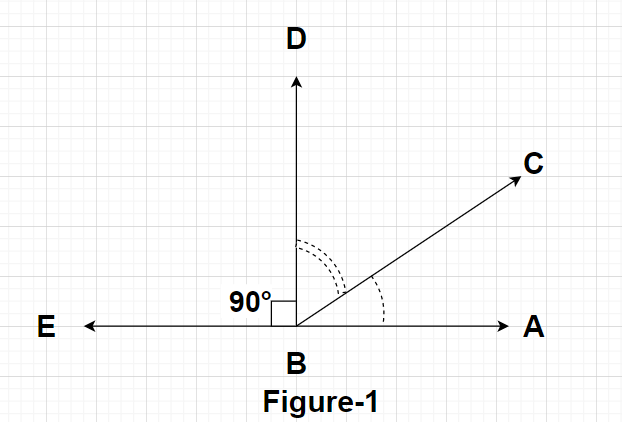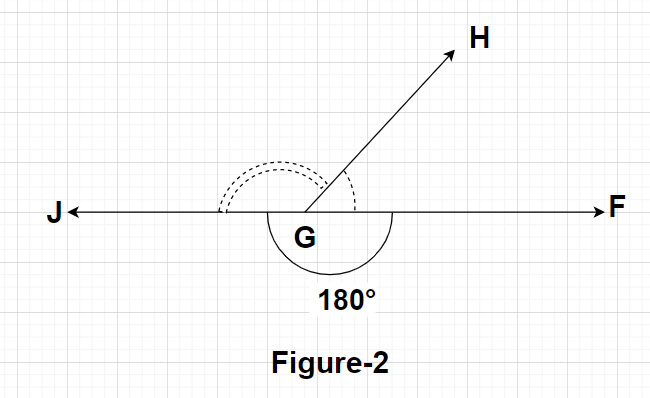
What are complementary and supplementary angles?
Answer
608.7k+ views
Hint: Here, we will be proceeding with the help of definition of complementary angles (sum of complementary angles is ${90^0}$) and supplementary angles (sum of supplementary angles is ${180^0}$) and then afterwards observing examples for each case.
Complete step-by-step answer:
The angles whose sum is equal to the measure of ${90^0}$ are called complementary angles. Complementary angles can be easily seen with the help of a diagram.

From Figure 1, we can say that $\angle {\text{DBE}} = {90^0}$ and $\angle {\text{ABE}} = {180^0}$
So, $\angle {\text{ABD}} = \angle {\text{ABE}} - \angle {\text{DBE}} = {180^0} - {90^0} = {90^0}$
Clearly, $
\angle {\text{ABD}} = \angle {\text{ABC}} + \angle {\text{CBD}} \\
\Rightarrow {90^0} = \angle {\text{ABC}} + \angle {\text{CBD}} \\
\Rightarrow \angle {\text{ABC}} + \angle {\text{CBD}} = {90^0}{\text{ }} \to {\text{(1)}} \\
$
From equation (1), we can say that since the sum of angles $\angle {\text{ABC}}$ and $\angle {\text{CBD}}$ is equal to ${90^0}$ so these two angles are known as complementary angles.
The angles whose sum is equal to the measure of ${180^0}$ are called supplementary angles. Supplementary angles can be easily seen with the help of a diagram.

From Figure 2, we can say that $\angle {\text{FGJ}} = {180^0}$
So, $
\angle {\text{FGJ}} = \angle {\text{FGH}} + \angle {\text{HGJ}} \\
\Rightarrow {180^0} = \angle {\text{FGH}} + \angle {\text{HGJ}} \\
\Rightarrow \angle {\text{FGH}} + \angle {\text{HGJ}} = {180^0}{\text{ }} \to {\text{(2)}} \\
$
From equation (2), we can say that since the sum of angles $\angle {\text{FGH}}$ and $\angle {\text{HGJ}}$ is equal to ${180^0}$ so these two angles are known as supplementary angles.
Note: If we consider all the interior angles of any triangle, then we can say that all these interior angles of any triangle constitutes supplementary angles because the sum of all the interior angles of a triangle gives a measure of ${180^0}$ (according to the property of a triangle).
Complete step-by-step answer:
The angles whose sum is equal to the measure of ${90^0}$ are called complementary angles. Complementary angles can be easily seen with the help of a diagram.

From Figure 1, we can say that $\angle {\text{DBE}} = {90^0}$ and $\angle {\text{ABE}} = {180^0}$
So, $\angle {\text{ABD}} = \angle {\text{ABE}} - \angle {\text{DBE}} = {180^0} - {90^0} = {90^0}$
Clearly, $
\angle {\text{ABD}} = \angle {\text{ABC}} + \angle {\text{CBD}} \\
\Rightarrow {90^0} = \angle {\text{ABC}} + \angle {\text{CBD}} \\
\Rightarrow \angle {\text{ABC}} + \angle {\text{CBD}} = {90^0}{\text{ }} \to {\text{(1)}} \\
$
From equation (1), we can say that since the sum of angles $\angle {\text{ABC}}$ and $\angle {\text{CBD}}$ is equal to ${90^0}$ so these two angles are known as complementary angles.
The angles whose sum is equal to the measure of ${180^0}$ are called supplementary angles. Supplementary angles can be easily seen with the help of a diagram.

From Figure 2, we can say that $\angle {\text{FGJ}} = {180^0}$
So, $
\angle {\text{FGJ}} = \angle {\text{FGH}} + \angle {\text{HGJ}} \\
\Rightarrow {180^0} = \angle {\text{FGH}} + \angle {\text{HGJ}} \\
\Rightarrow \angle {\text{FGH}} + \angle {\text{HGJ}} = {180^0}{\text{ }} \to {\text{(2)}} \\
$
From equation (2), we can say that since the sum of angles $\angle {\text{FGH}}$ and $\angle {\text{HGJ}}$ is equal to ${180^0}$ so these two angles are known as supplementary angles.
Note: If we consider all the interior angles of any triangle, then we can say that all these interior angles of any triangle constitutes supplementary angles because the sum of all the interior angles of a triangle gives a measure of ${180^0}$ (according to the property of a triangle).
Recently Updated Pages
Master Class 6 English: Engaging Questions & Answers for Success

Master Class 6 Social Science: Engaging Questions & Answers for Success

Master Class 6 Maths: Engaging Questions & Answers for Success

Master Class 6 Science: Engaging Questions & Answers for Success

Class 6 Question and Answer - Your Ultimate Solutions Guide

Master Class 11 Economics: Engaging Questions & Answers for Success

Trending doubts
How many millions make a billion class 6 maths CBSE

How many seconds are there in an hour class 6 maths CBSE

What is meant by the term Universal Adult Franchis class 6 social science CBSE

Why is democracy considered as the best form of go class 6 social science CBSE

Four bells toll together at 900am They toll after 7811 class 6 maths CBSE

A clock is set to show the correct time at 11 am the class 6 maths CBSE





